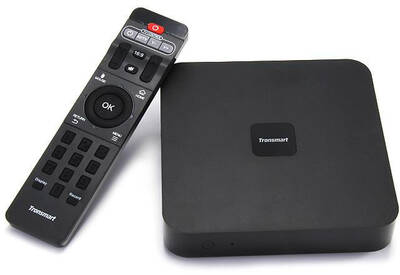**This is an old revision of the document!**
Tronsmart Pavo M9
Also known as “Android Box” or “the tronsmart”.
- Vendor website http://www.tronsmart.com/products/tronsmart-pavo-m9

- SoC – Mstar MSO9180D1R quad core Cortex A9 processor up to 1.5GHz with a Mali-450MP2 GPU
- System Memory – 1GB DDR3
- Storage – 8GB eMMC flash + micro SD slot
- Video Output / Input – HDMI output up to 4K, HDMI input with PVR and Time Shifting support (up to 1080p), and AV port (Composite + stereo audio)
- Audio I/O – HDMI Out and In, AV, and optical S/PDIF
- (Main) Video Codecs – H265, VC-1, WMV-HD, MPEG1/2/4 up to 4Kx2K, etc..
- Audio Codec – MP3, AAC, AC3, DTS-HD Master, TrueHD 7.1 pass-through, etc…
- Connectivity – 10/100M Ethernet, 802.11 b/g/n Wi-Fi (Realtek 8188)
- USB – 1x USB 3.0, 2x USB 2.0 host ports.
- Misc – ON/OFF switch, IR receiver
- Power Supply – 12V/2A
- Dimensions – 15.24 x 15.24 x 4.06 cm
- Weight – ~260 grams
- Android 4.1*, root available without modification
Overview
This product seems to be out of production but is sometimes still available from chinese online stores. Its most important feature is the HDMI input which can be used to capture / stream / scale an HDMI signal
As a frame rate converter
In 2016/2017 we changed the default event cases setup, we using the Pavo M5 to convert the projector signal to 1080p24, which we can feed into a BMD DeckLink capture cards Mini Recoder HDMI PCI capture card. In contrast to a H264 stream over ethernet, the latency is much lower. To have this reboot save, one have to install an autostart app to run the HDMI app after boot. The autostart app is available in the aptoide store – which comes with the default firmware.
As a ethernet stream source
ZidoStreamer
The ZidoStreamer app allows to stream the HDMI input via Ethernet / wifi to a stream sink
To be able to use ZidoStreamer an ffmpeg binary compiled for the ARM CPU needs to be placed /mnt/sdcard
Such an binary can be found e.g. here
scripts
Here are some example command lines for ffmpeg that we use
/mnt/sdcard/ffmpeg -i - -c copy -absf aac_adtstoasc -f flv rtmp://100.122.3.243:1935/source/tronsmart
ZidoStreamer ist auf eine Videobitrate von 20Mbit/s und 26 fps eingestellt. Bei 25 fps flackert's in voctomix. Audio staht auf 320kbit/s, wird aber nicht ausgenutzt.
RTMP stream to voctomix:
#!/bin/sh
confdir="`dirname "$0"`/../"
. $confdir/default-config.sh
if [ -f $confdir/config.sh ]; then
. $confdir/config.sh
fi
ffmpeg -y -nostdin -xerror \
-f flv -i "rtmp://127.0.0.1/source/tronsmart" \
-filter_complex "
[0:v] scale=$WIDTH:$HEIGHT,fps=$FRAMERATE [v];
[0:a] aresample=$AUDIORATE [a]
" \
-map "[v]" \
-c:v rawvideo \
-pix_fmt yuv420p \
-map "[a]" -ac 2 \
-c:a pcm_s16le \
-f matroska \
tcp://localhost:10002
Dieses Skript hat den Vorteil, dass Audio, was über die HDMI Verbindung geschickt wird im voctomix zur Verfügung steht und synchron mit dem Video ist. Bietet sich vor allem dann ann, wenn der Vortragende ein Video abspielt und viel im Video gesprochen wird, da man Voctomix dann auf diese Audioquelle umstellen kann.
Oder alternativ mit gstreamer:
#!/bin/sh
confdir="`dirname "$0"`/../"
. $confdir/default-config.sh
if [ -f $confdir/config.sh ]; then
. $confdir/config.sh
fi
gst-launch-1.0 -vvv\
rtmpsrc location=rtmp://127.0.0.1/source/tronsmart ! queue ! flvdemux name=demux ! queue !\
h264parse ! avdec_h264 !\
videoscale ! \
videoconvert ! \
videorate ! \
video/x-raw,format=I420,width=$WIDTH,height=$HEIGHT,framerate=$FRAMERATE/1,pixel-aspect-ratio=1/1 ! \
mux. \
\
audiotestsrc freq=550 !\
audio/x-raw,format=S16LE,channels=2,layout=interleaved,rate=$AUDIORATE !\
mux. \
\
matroskamux name=mux !\
tcpclientsink host=localhost port=10002

